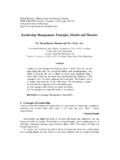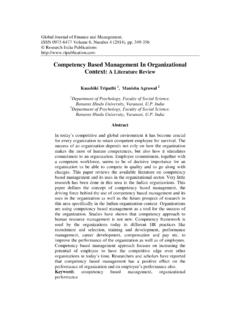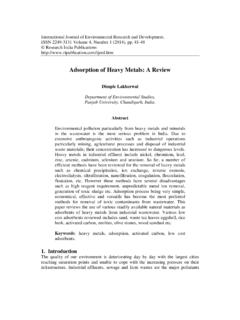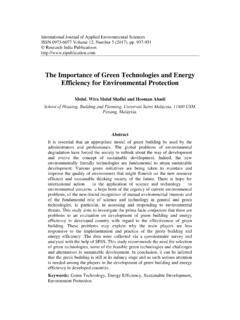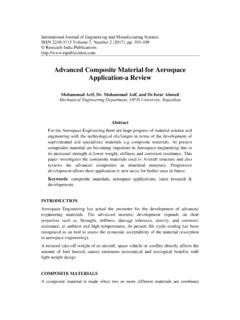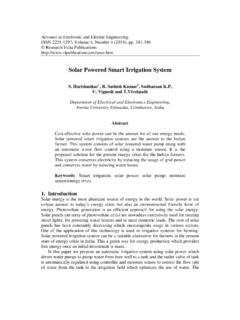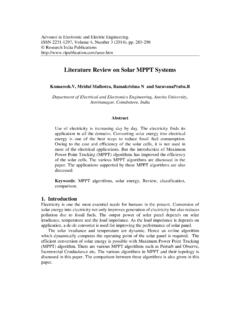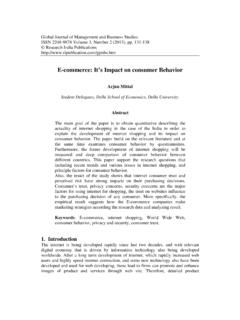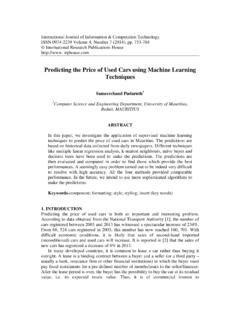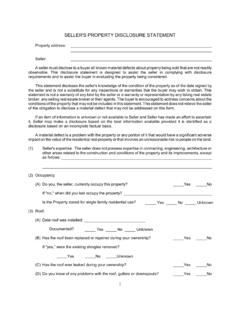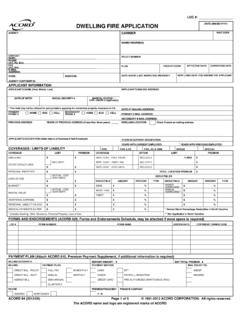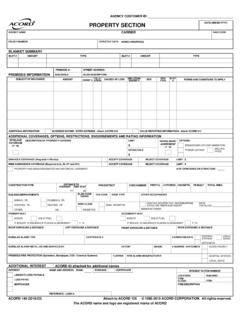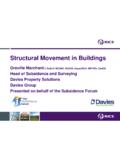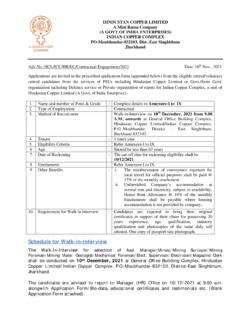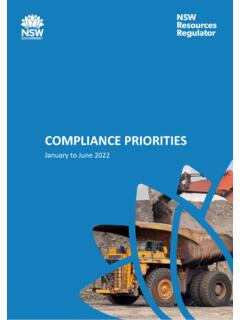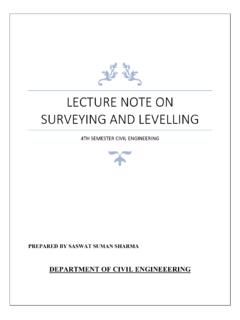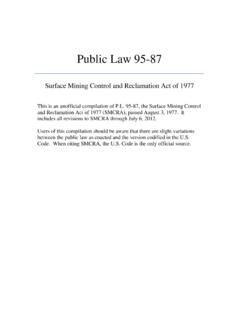Transcription of Environment Impact Assessment of Coal Mining
1 International Journal of Environmental Engineering and Management. ISSN 2231-1319, Volume 4, Number 3 (2013), pp. 245-250 Research India Publications Environment Impact Assessment of Coal Mining Dhruv Katoria1, Dhruv Sehgal2 and Sameer Kumar3 1 Department of Environmental Engineering, Delhi Technological University ShahbadDaulatpur, Main Bawana Road, New Delhi, INDIA. 2, 3 Department of Environmental Engineering, Delhi Technological University ShahbadDaulatpur, Main Bawana Road, New Delhi, INDIA. Abstract Environmental Impact Assessment is a decision making tool to predict the effect of a proposed activity/ project on the Environment , to compare various alternatives for a project and to identify best combination of economic, environmental and social costs and benefits. Coal Mining is the process of extracting the coal from the deep underground mines in the earth crust.
2 Coal Mining is one of the most illegal activities going on in the country. At the same time it totally neglects the role of EIA in its pre-operational, during Mining and post operational plans. Here various case studies of coal Mining are done and the Impact of coal Mining to the Environment is looked into with some measures to mitigate this problem with proper use of technology and generation of awareness. The Impact of coal Mining on land, water, health of workers, air and social Impact on surrounding villages and cities is evaluated and Environment management plan of coal Mining is developed. Therefore, the coal has to be used sustainably as coal reserves are depleting rapidly. 1. Introduction Coal is a non-renewable fossil fuel Formed from the remains of plants that lived and died about 100 to 400 million years ago.
3 Depth, thickness, and configuration of minerals resource decide the selection of Mining technology (open cast or underground).Minerals exploitation progresses through four stages: Prospecting means search for deposits. Exploration: Once the deposit is assured, this is done to assess the size, shape, location and economic value of the deposit. Development - Work of preparing access to the deposit so that the coal can be extracted Exploitationmeans Dhruv Katoria et al 246extraction of coal. Depending on the content of volatiles, coal is classified into Lignite, Sub-bituminous coal, Bituminous coal and Anthracite. Open cast Mining and underground Mining (room pillar, long wall, drift, shaft, slope Mining ) are some types of coal Mining . Proper Environment Impact Assessment of coal Mining is very important and here we take some issues which should be considered and some mitigation measures are discussed.
4 2. Environment and Social issues related to coal Mining Coal Mining has significant Impact on land and land use, some of the land related Impact are: Loss of biodiversity, Economic loss or loss of livelihood due to displacement and encroachment of agricultural land and Impact on water resource (in term of water availability and quality). Open cast mine has significant Impact on land as compared to underground mine. 1) Land - Around 4 ha of land is damaged for every million tons of coal mined by the surface Mining . For instance, a capacity of 10 million-tons opencast coal mine in 20 years has a potential to destroy around 800 ha of land 2) Air - Mainly in the form of Fugitive Dust. Most Mining operations generate dust such as Drilling, blasting, Vehicles movement on haul roads, Collection, transportation and handling of coal, Screening, sizing and segregation and example, a coal stack of 50,000 tonnes can generate 250 tonne of fugitive dust even if assuming loss of only per cent as fugitive dust.
5 3) Water - Breaching of groundwater affects the local water availability. High risk to alter the water quality of areas low pH, increase in total solids, TDS and heavy metal concentration. Acid mine drainageproduced by the leaching of sulphide minerals present in the coal leaves a Direct Impact on drinking water quality,aquatic life and corrosion of equipment and structures. Trace of arsenic and hexavalent chromium around ppm has been found. 4) Solid Waste - Overburden of organic material and soil that overlie a mineral deposit. Overburden generation is denoted by stripping ratio which is the ratio of overburden that needs to be removed to the amount of ore removed. Low stripping ratio translates into low quantities of waste. Mining operation results in excavation of large quantities of top soil. It is precious as it holds nutrients and is essential for successful rehabilitation and soil management and its reuse are important.
6 Poor storage can lead to run-off. 5) Noise and vibration - Cumulative effect of Mining activities produces considerable noise like blasting, drilling, crushing and movement of vehicles. Blasting results in ground vibrations and if there are human habitation nearby, it can destroy property and houses 6) Occupational health - The workers in mine have high risk of the occupational diseases:Pneumoconiosis: Due to inhalation of coal dust. Can cause severe lung Environment Impact Assessment of Coal Mining 247 problems and lung cancer, Dust allergy and asthma, Noise hazard such as temporary or permanent hearing loss, headache and high blood pressure. 7) Mine fires -an issue for not only the workers but also the people living in adjoining area is a major problem. Jharia coal mines :In 1972, there were reportedly, 70 active fires over an area of 17 Presently 9 sq.
7 Km is still affected by fire even after spending Rs 115 crores. Raniganj coal mines :Out of 850 hectare land in Raniganj town, 90 hectares affected by fire and subsidence . 8) Socio economic factor - Coal Mining affects communities at multiple levels. During mine s opening Displacement, Loss of livelihood During mine s operation - Pollution Impact (air, water, noise, vibration), Health Impact Mine closure - Sudden economic halt and Land contamination Parameter Waste water discharge from ledo mines Stream water sample D/S of the mines Ph Cadmium Chromium 455 73 Lead 4846 1098 Arsenic 226 Mercury 119 This table shows the condition of a coal mine in Assam, Coal has high sulphur content and thus problem of AMD Ledo, Tirap and waterand surface water contaminated. 3. Mitigation and Environment management plan EMP is a framework for the implementation and execution of mitigation measures and alternatives.
8 Ideally EMP should covers all phases of project development Pre-construction, Operation of mine and Decommissioning of the mine. It is a Documented plan Containing details of impacts, recommended mitigation and monitoring measures etc and Legal document based on which the performance is monitored 1) Top soil management - The best practices for topsoil management is toScrap the topsoil prior to drilling and blasting, Scraped topsoil should be used immediately for plantation/agriculture, If it is not possible to use the topsoil immediately, then it should be stacked at a designated area, Storage must be done in a pyramidal form, with garland drains all around. 2) Overburden management - If an external overburden dump is unavoidable, then it should be stabilized with biological reclamation .Excavation from a new pit should begin after an existing pit has been exhausted.
9 This would ensure that the overburden and interburden generated is used for backfilling the exhausted pit, instead of being dumped a pit is exhausted, the Dhruv Katoria et al 248overburden should be compacted and stacked in specified locations in low-lying, non-mineralized zones within the lease should be planted over the dump slopes as early as height and slope of the overburden dumps should be maintained to prevent slope tanks should be constructed to treat run-off from external overburden dumps. For external overburden dumps, the bench height should not exceed 10 meters and the final dump height should not be more than 60 meters. For Gondwana period rock strata, the slope should not exceed 28 degrees. 3) subsidence management -Planned subsidence by considering surface structures and human lives, as in the case of long-wall Mining .
10 Preparation of a subsidence management plan and its approval by the regulatory agency. The plan should ensure the following:Simultaneous stowing of the de-coaled area. Compensation to and rehabilitation of the affected people. Fencing of the subsidence zone during active Mining operation to prevent unintended entry into the affected area. Reclaiming the subsided area by afforestation. Regular monitoring and inspection of subsidence area to detect any subsidence and taking the necessary a subsidence monitoring programme that covers the Impact of subsidence on surface and groundwater (quality and quantity) and its management 4) Management of water pollution - Use of mine seepage water (after treatment) for different purposes, Construction of gabbion wall, garland drain, siltation pond, wherever appropriate and Coal stockpiles, overburden and topsoil should be selectively placed in a stable area which is less prone to erosion.
